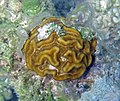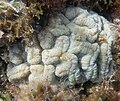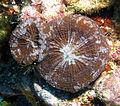Faviidae
| Faviidae | ||||||||||
|---|---|---|---|---|---|---|---|---|---|---|
(c) Diego Delso, CC BY-SA 4.0 Favia favus | ||||||||||
| Systematik | ||||||||||
| ||||||||||
| Wissenschaftlicher Name | ||||||||||
| Faviidae | ||||||||||
| Milne Edwards & Haime, 1857 |
Die Faviidae sind eine Familie der Steinkorallen (Scleractinia). Die Familie ist heute auf ihre atlantischen Gattungen beschränkt. Die ehemals den Faviidae zugeordneten Gattungen des Indopazifiks wurden der Familie Lobophylliidae zugeordnet. Wie die meisten anderen Steinkorallen leben sie in einer symbiotischen Beziehung mit kleinen Algen (Zooxanthellen), die die Koralle mit Nährstoffen versorgen. Sie sind deshalb auf helle Standorte angewiesen.
Aussehen
Viele Arten wachsen in großen Kolonien und erreichen Durchmesser von mehreren Metern. Wegen des massiven Skelettaufbaus ist ihr Wachstum sehr langsam. Große Kolonien müssen daher hunderte von Jahren alt sein. Das Muster der großen Polypen erinnert oft an die Windungen eines Gehirns. Sie bekamen deshalb den deutschen Namen Hirnkorallen.
Gefährdung
Hirnkorallen können auch in gut gepflegten Meerwasseraquarien kultiviert werden. Die kompakt wachsenden Arten aus der Familie Faviidae können allerdings nicht so leicht vermehrt werden, wie die ästig wachsenden Acroporen und Montiporen. Sie werden deshalb immer noch stark in den Korallenriffen gesammelt. Dabei werden Teile der Korallenstöcke mit dem Meißel herausgeschlagen und der Mutterstock stark geschädigt. Die Faviidae sind wie andere großpolypige Steinkorallen vielerorts schon selten geworden.
Gattungen

- Unterfamilie Faviinae Milne Edwards & Haime, 1857
- Colpophyllia Milne Edwards & Haime, 1848
- Diploria Milne Edwards & Haime, 1848
- Favia De Blainville, 1820
- Manicina Ehrenberg, 1834
- Mussismilia Ortmann, 1890
- Pseudodiploria Fukami, Budd & Knowlton, 2012
- Unterfamilie Mussinae Ortmann, 1890
- Isophyllia Milne Edwards & Haime, 1851
- Mussa Oken, 1815
- Mycetophyllia Milne Edwards & Haime, 1848
- Scolymia Haime, 1852
- Diploastrea heliopora
- Manicina areolata
- Pseudodiploria strigosa
- Isophyllia sinuosa
- Mussa angulosa
- Mycetophyllia alliciae
- Scolymia cubensis
Weblinks
- Hoeksema, B. W.; Cairns, S. (2023). World List of Scleractinia. Faviidae Milne Edwards & Haime, 1857.
Auf dieser Seite verwendete Medien
Autor/Urheber: Nhobgood Nick Hobgood, Lizenz: CC BY-SA 3.0
Mycetophyllia alliciae (Knobby Cactus Coral).
Autor/Urheber: James St. John, Lizenz: CC BY 2.0
Manicina areolata (Linnaeus, 1758) - rose coral on a patch reef.
Stony corals have a patchy distribution in the shallow marine waters surrounding San Salvador Island. They occur as isolated individual colonies, in patch reefs, fringing reefs, and barrier reefs. Stony corals are scleractinian anthozoan cnidarians (there are also non-scleractinian stony corals in the fossil record, such as tabulates and rugosans). They consist of individuals or colonies of gelatinous polyps that secrete hard skeletons of aragonite (CaCO3). Most scleractinian corals live in warm, tropical to subtropical, photic zone environments (the shallow portions of the world’s oceans where sunlight penetrates). Microbes (Symbiodinium - Protista, Dinoflagellata/Pyrrhophyta) called zooxanthellae live in their tissues and need to be in sunlight to make their own food (photosynthesis), which is shared with the host coral animal. Scleractinian corals have stinging cells (nematocysts) in their tentacles that paralyze prey.
The rose coral in the above photo has slender tentacles that are retracted into grooves during the day. At night, the coral extends its tentacles and feeds.
Classification: Animalia, Cnidaria, Anthozoa, Scleractinia, Faviidae
Locality: Lindsay Reef, southern Long Bay, offshore western San Salvador Island, eastern BahamasAutor/Urheber: Paul Asman and Jill Lenoble, Lizenz: CC BY 2.0
by symmetrical brain coral Diploria strigosa
(c) Diego Delso, CC BY-SA 4.0
Coral (Favia favus), Ras Muhammad National Park, Red Sea, Egypt. This species of stony corals is massive and forms thickly encrusting dome-shaped colonial corals. There is a great diversity of form even among the same species. The corallites project slightly above the surface of the coral and each has its own wall. The septa and costae linked to the corallite wall are well developed and covered by fine teeth. The polyps only extend and feed during the night. Each one has a small number of tapering tentacles which often have a darker coloured tip; these are called stinger tentacles, or sweeper tentacles. They use these to sweep the water to see if any other coral is in its area; if so, then they begin to sting the other coral. This is commonly known as coral war. Each coral is trying to make sure it has enough room around it so it can continue to grow and have more surface area for its offspring.
Scolymia cubensis, la imagen muestra un pólipo junto a su hijo, tras un proceso de gemación, o reproducción asexual
Autor/Urheber: Nhobgood Nick Hobgood, Lizenz: CC BY-SA 3.0
Colpophyllia natans (Boulder Brain Coral) entire colony
Autor/Urheber: Chaloklum Diving, Lizenz: CC BY-SA 4.0
Diploastrea heliopora en Koh Phangan, Tailandia
Mussa angulosa en Flower Garden Banks
















